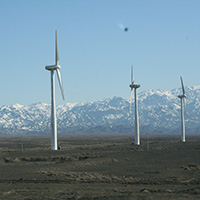
World's top CO2 emitter on track to reach key climate goal by 2030
Valerie Karplus | ChinaFAQs
Based on recent economic developments and the newly-released Thirteenth Five-Year Plan, China is well on its way to reaching its climate goal of peak CO2 emissions by 2030.
The Plan charts the overarching course of China’s economic and social development through 2020, and will be translated into plans for provinces and specific sectors like energy in the coming months and years. The national plan, by reflecting the government’s high-level priorities, provides important momentum toward meeting China’s climate change commitments.
In many respects, the Plan hews closely to the goals set out in the country’s previous long-term energy plans and its climate policy commitments for the Paris Agreement. China’s pledge included targets to reach peak CO2 emissions around 2030 (with the intention to peak earlier), by reducing the CO2 intensity of economic activity by 60-65% by 2030 relative to 2005, and raising the share of non-fossil energy in the country’s energy mix to around 20% by 2030.
In crafting the Plan, China’s policymakers have emphasized the role of both the expansion of low-carbon energy and continued improvements in energy efficiency. It suggests that even in the face of slower growth, top policymakers recognize that both strategies are consistent with the country’s latest growth targets.
Moving forward on climate and energy
Generally speaking, the Plan is in step with the country’s National Energy Development Plan, released in 2014, which calls for substantial increases in clean and renewable energy deployment through 2020. While the new Five-Year Plan does not mention targets for installed electricity generation capacity, it reaffirms the country’s existing target to raise the non-fossil share of energy use to 15% by 2020. To achieve this goal, China’s National Energy Administration has stated that China will need a total of 250 gigawatts (GW) of wind power capacity, and 150 GW of solar, which would exceed the targets set in 2014 by 50 gigawatts each. (China is also aiming for 350 GW of hydropower capacity by 2020.) Realizing the full generation potential of wind and solar capacity—and its contribution to the country’s non-fossil target—will require reforms that introduce greater flexibility in dispatch and allow balancing across larger grid areas.
Nuclear and biomass are also slated to expand substantially, by 38-49 GW and 30 GW, respectively (Bloomberg New Energy Finance). Expansion of the country’s natural gas infrastructure is also likely to facilitate increased use, which has not occurred as fast as anticipated through 2015.
Energy efficiency will also be critical, especially realizing efficiencies in the parts of the economy that policy doesn’t easily reach. Indeed, many of the large energy users and emitters have cleaned up substantially in recent years in response to energy efficiency directives and technology upgrades. While there may be little low hanging fruit left in some segments of the economy, finding, reaping, and quantifying the remaining opportunities for energy efficiency improvement will be an important task in the Thirteenth FYP.
The creation of a national carbon trading market—focused on large enterprises in high-emitting sectors—will help to support this transition. Set to launch in 2017, the system will price in a portion of the damages of fossil energy use, encouraging clean energy substitution and innovation over the longer term. Finding ways to expand the coverage of the carbon price to smaller and more distributed emitters offers a promising way to expand cost-effective reductions, while preventing “leakage” of emitting activities from covered to un-covered sectors.
As in past Plans, the Thirteenth FYP lays out energy and CO2 intensity reduction targets. The plan targets an energy intensity reduction of 15% (the Twelfth FYP targeted 16%, while the Eleventh FYP targeted 20%). The targeted CO2 intensity reductions of 18%, compared to 17% for the Twelfth Five-Year Plan, will boost the contribution of low-carbon sources in the energy mix and support further decoupling of China’s economic growth from its reliance on fossil energy. This shift is already well underway—China’s share of coal in primary energy has dropped from over 72% in 2007 to 64% in 2016. The CO2 market will be designed to contribute substantially to sustaining reductions in CO2 intensity, in line with the 18% goal.
A shift toward consumption and services
A shift away from investment and exports toward consumption and services as key economic growth drivers in the coming years now seems to be underway in earnest, and will further contribute to reductions in emissions, relative to a no-shift scenario. In this regard, the government’s objectives are aligned with domestic environmental goals. China’s progress provides lessons for emerging economies generally to help in avoiding an emissions-intensive development path.
All of these developments, while not surprising, are reassuring. Combined with the 6.5%/year average annual growth the Plan targets, the latest energy and CO2 intensity goals could translate into a CO2 emissions peak well before 2030, in keeping with China’s pledge to make best efforts to peak early.
Author Information: Dr. Valerie J. Karplus, a ChinaFAQs expert, is an Assistant Professor in the Global Economics and Management Group at the MIT Sloan School of Management, and is the Faculty Lead of the China Energy and Climate Project in the MIT Joint Program on the Science and Policy of Global Change.
ChinaFAQs is a project facilitated by the World Resources Institute that provides insight into critical questions about Chinese policy and action on energy and climate change. The ChinaFAQs network is comprised of U.S.-based experts, including researchers at U.S. universities and government laboratories, independent scholars, and other professionals.
Photo: Kaj17 via Flickr Creative Commons License

